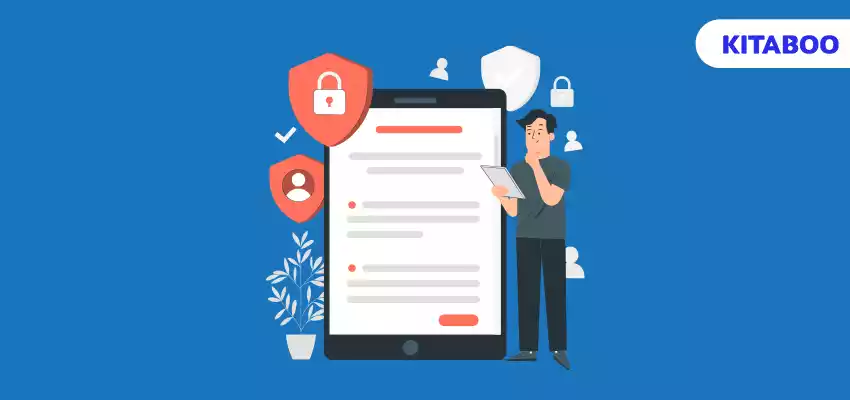
eBook DRM: Enhancing Your Reading Experience Securely
Summarize this blog with your favorite AI:
Digital content has become a big part of our lives, making it easy for us to access lots of different stuff. But this also means it’s tougher for creators and publishers to protect their work from being shared illegally. That’s where eBook DRM comes in.
DRM helps publishers keep their content safe from unauthorized sharing. By employing various methods, publishers can monitor distribution channels and exert control over their material in the long run.
In this blog, we will explore the concept of eBook DRM and how it can ultimately enhance the reading experience to benefit consumers and creators alike.
Table of Contents:
I. Understanding The Concept of eBook DRM
II. The Advantages of Implementing eBook DRM
- Safeguarding Against Piracy
- Content Monetization
- Control Over Content Access
- Flexible Licensing Strategies
III. The Impact of eBook DRM on Users
IV. Wrapping Up
Understanding The Concept of eBook DRM
eBook Digital Rights Management (DRM) refers to a set of protocols and methods that allows publishers to safeguard their digital assets from attempts at unauthorized access and distribution. Methods such as encryption and watermarking help creators protect their content from the hands of piracy, ensuring that they are able to control access to their digital assets.
DRM implementations have historically been criticized for being too restrictive and inhibiting the freedom of consumers who fairly gain access to digital content.
However, more modernized implementations of this philosophy are able to strike a balance between user comfort and asset protection to create a system that is favorable for both ends of the spectrum.
Inconspicuous encryption methods and seamless eBook reader integration help consumers access their content in a convenient manner while allowing publishers to oversee its distribution.
Digital textbook platforms such as KITABOO allow authors and publishers to protect their content from unauthorized use through the implementation of encryption to secure its access. This also helps prevent piracy and ensures that creators are fairly compensated for their work.
The Advantages of Implementing eBook DRM
Implementing robust eBook DRM techniques provides creators and publishers with the following benefits:
1. Safeguarding Against Piracy
Although creating a better user experience may help mitigate piracy, publishers always run the risk of it cutting into their content distribution rollouts and strategies. eBook DRM, such as data encryption, allows creators to maintain visibility over access to their digital assets, helping to prevent unauthorized access, sharing, and distribution.
Digital textbook platforms such as KITABOO enable authors and publishers to mitigate the effects of content piracy by safeguarding their assets from unauthorized access and distribution. Publishers can control how long users can access content and how it can be viewed.
2. Content Monetization
eBook DRM allows publishers to monetize their digital content and prevent unauthorized access effectively.
Publishers can rent their content, implement subscription models, or opt for single-use purchases to receive the fruits of their effort and labor. eBook DRM can also be implemented to enable the functioning of supplementary content in eBooks, enabling creators to include different kinds of content promotions in their marketing strategies.
3. Control Over Content Access
eBook DRM allows publishers to have greater control over how their content is accessed and by which parties, enabling them to exert their influence over how their assets are distributed, used, or recreated.
Publishers can implement different policies, such as restricting access to rented content to a specified number of times or only allowing access to digital content on a certain number of devices or platforms.
4. Flexible Licensing Strategies
Utilizing eBook DRM empowers publishers with the flexibility to tailor licensing strategies according to their preferences. This enables them to institute a variety of content access models, ranging from limited-time access to specific devices to more liberal access options. Even while extending accessibility, DRM ensures safeguards are in place to mitigate unfair usage of digital content.
The Impact of eBook DRM on Users
While DRM as a whole can be considered a restrictive method of controlling access to content by some, eBook DRM offers several advantages to users that can greatly enhance the viewing experience.
Here’s a snapshot of some of the ways eBook DRM can impact users positively:
1. Greater Content Accessibility
Although this might sound counterintuitive to the concept of DRM, eBook DRM can allow users to access a wide selection of diverse content on different platforms. With the ease of use these platforms offer, accessing content has now become as simple as clicking a single button.
2. Content Authenticity
Going down the rabbit hole of pirated content can cause users to run into malicious files intended to disrupt user systems or receive altered content that is questionable in its validity.
The implementation of stable DRM methods helps publishers provide authorized access to authentic content, providing readers with the best possible experience and the correct information.
3. Support for Authors and Publishers
Implementing eBook DRM allows authors and publishers to monetize their content and effectively make their livelihood from it while reducing the damages they might incur from unauthorized access.
Supporting authors in a fair way by purchasing authentic content helps readers support their favorite writers and helps them to continue creating content for their cherished demographics.
Wrapping Up
eBook DRM techniques are typically designed to be unobtrusive, working in the background so as not to affect the reading experience while still continuing to protect the livelihoods of authors and publishers.
By ensuring secure access and controlled distribution of eBooks, DRM can foster a healthy digital marketplace where creators are fairly compensated, and readers enjoy a vast selection of legitimate content.
However, it’s important to acknowledge that the effectiveness of DRM is an ongoing debate. Some argue for more open formats that prioritize user ownership, while others emphasize the need for strong copyright protection.
Digital textbook platforms like KITABOO empower authors and publishers to create DRM-protected eBooks within a secure, cloud-based distribution system. This system encrypts content, ensuring authorized distribution and access. Notably, the platform allows users to access eBooks offline while maintaining content integrity.
Team up with us now!
Discover how a mobile-first training platform can help your organization.
KITABOO is a cloud-based platform to create, deliver & track mobile-first interactive training content.


![Top 5 Free Publishing Sites for Independent Publishing [2026]](https://kitaboo.com/wp-content/uploads/2025/09/Top-5-Free-Publishing-Sites-for-Independent-Publishing-2026-420x235.webp)
